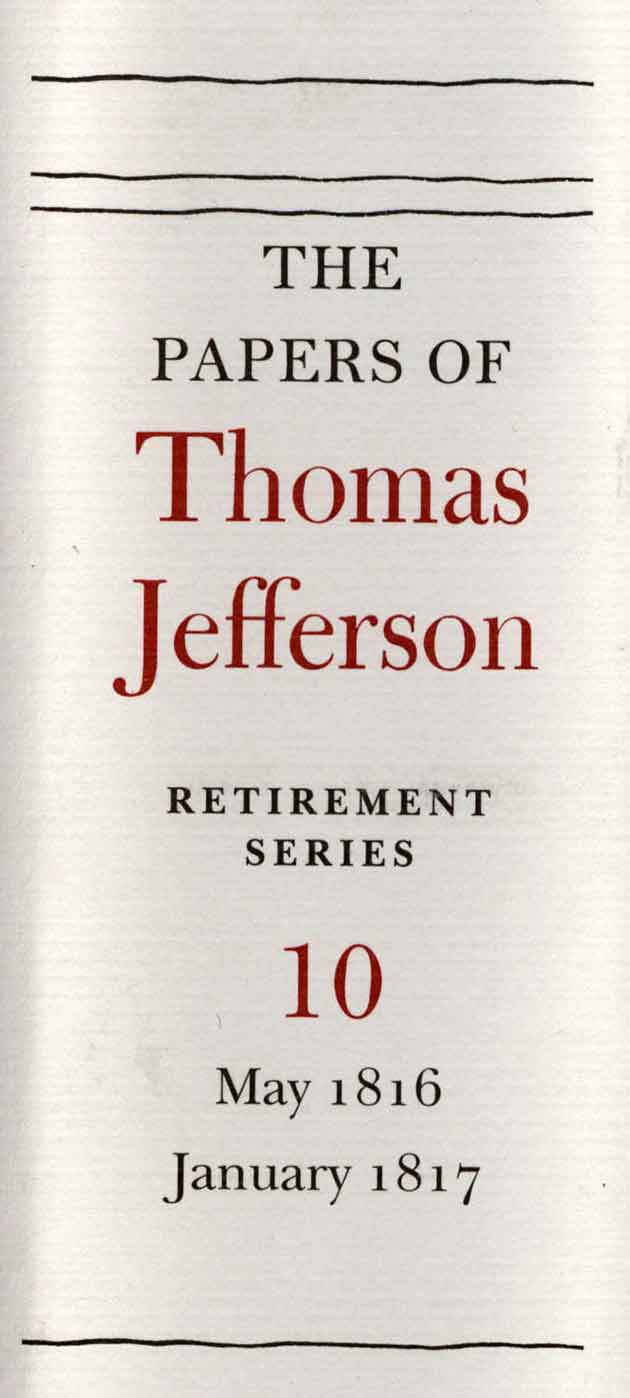 The 558 documents in this volume cover the period from 1 May 1816 to 18 January 1817. As heretofore, Thomas Jefferson followed current events closely. Although pleased by Napoleon’s downfall, he was dissatisfied with the political settlement that brought peace to Europe after a generation of warfare. In the short term, Jefferson expected a political upheaval in Great Britain, continued uncertainty in France, and the expulsion of Spain from its colonies in the New World. In the United States, he hailed the Federalists’ dwindling electoral prospects and welcomed the forthcoming presidential transition from James Madison to James Monroe. Jefferson also advised against the installation of an inscription commemorating the British destruction of the United States Capitol and recommended that John Trumbull be hired to execute historical paintings for the restored structure.
The 558 documents in this volume cover the period from 1 May 1816 to 18 January 1817. As heretofore, Thomas Jefferson followed current events closely. Although pleased by Napoleon’s downfall, he was dissatisfied with the political settlement that brought peace to Europe after a generation of warfare. In the short term, Jefferson expected a political upheaval in Great Britain, continued uncertainty in France, and the expulsion of Spain from its colonies in the New World. In the United States, he hailed the Federalists’ dwindling electoral prospects and welcomed the forthcoming presidential transition from James Madison to James Monroe. Jefferson also advised against the installation of an inscription commemorating the British destruction of the United States Capitol and recommended that John Trumbull be hired to execute historical paintings for the restored structure.
While contending in Virginia with an extraordinary drought and unseasonably cold weather, as well as torrential rainfall and widespread flooding, Jefferson contributed privately to the debate over amending the state constitution. In three letters to Samuel Kercheval and in notes he compiled on the same subject, he suggested a number of substantial alterations: an expanded male franchise, equal electoral districts, popular gubernatorial elections, the elimination of the Council of State, and the division of each county into wards, among others. In addition, Jefferson prepared a legal defense against the claims of the three youngest heirs of Bennett Henderson, who had decided not to confirm the sales of their Milton lands made during their minority; and he gave occasional legal advice, including an opinion on the possibility of committing perjury before a grand jury.
Jefferson grieved over the deaths of Philip Mazzei and Gouverneur Morris and complained about the burden posed by his extensive personal correspondence. He rejected requests that he sell Natural Bridge or forward advice about the internal governance of an agricultural and manufacturing society composed of expatriated Frenchmen. He also calculated the latitude of both Poplar Forest and Willis’s Mountain; endeavored unsuccessfully to obtain a competent clockmaker for Charlottesville; exchanged the last of a long series of letters with Pierre Samuel Du Pont de Nemours on education and finance; and was appointed, along with Madison and Monroe, as a visitor of Central College. As usual, sojourners flocked to Monticello. Richard Rush, George Flower, and Josephus B. Stuart left brief accounts of their stays there, while the Baron de Montlezun and Francis Hall compiled lengthy, informative accounts of Jefferson’s home, art collection, and thoughts on a wide range of subjects. The diversity in Jefferson’s correspondence is also typified by Marcus Dyson’s explanation of an underwater breathing apparatus, Eusebio Valli’s intense discussion of the causes of yellow fever, and letters with John Adams about the functions of human grief, the earthly balance between pleasure and pain, and the hypothetical question of the willingness of the two men to live their lives over again.
Books remained central to Jefferson’s life. He spent much time and energy attempting to replace many of the volumes he had sold to Congress a year earlier. Moreover, Jefferson persisted in his quest to bring both the unpublished papers arising from the Lewis and Clark Expedition and Destutt de Tracy’s Treatise on Political Economy into print, and he provided Joseph Delaplaine with biographical information about himself and Peyton Randolph (ca. 1723–75) for Delaplaine’s Repository. The artist Bass Otis executed Jefferson’s life portrait, the first of his retirement, at Monticello for use in the latter publication, and shortly thereafter the sculptor Giuseppe Valaperta modeled a miniature likeness of him in wax. Jefferson also read and suggested revisions to drafts of Louis H. Girardin’s history of Virginia and William Wirt’s biography of Patrick Henry. Francis Adrian Van der Kemp and Jefferson exchanged a number of letters about the ex-president’s syllabus on the life and teachings of Jesus, a manuscript that Van der Kemp arranged to have anonymously published in England and that inspired him to outline his own proposed book on the subject.
Religion, indeed, is an important theme in Jefferson’s 1816 correspondence. After the ailing Charles Thomson circulated the mistaken idea that Jefferson had recently converted to Christianity, the former president was subjected to a new round of questions about his spiritual beliefs. He eventually asked Delaplaine to “say nothing of my religion. it is known to my god and myself alone. it’s evidence before the world is to be sought in my life. if that has been honest and dutiful to society the religion which has regulated it cannot be a bad one.”
Volume 10 available through:
UVA Press Rotunda (index included; subscription required)
Founders Online (index omitted; no subscription required)
COPYRIGHT NOTICE: Published by Princeton University Press and copyrighted, ©, by Princeton University Press. All rights reserved. No part of this book may be reproduced in any form by any electronic or mechanical means (including photocopying, recording, or information storage and retrieval) without permission in writing from the publisher, except for reading and browsing via the World Wide Web. Users are not permitted to mount this file on any network servers.